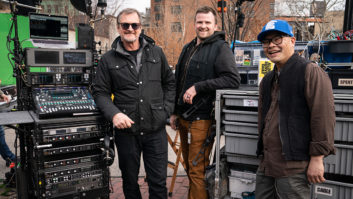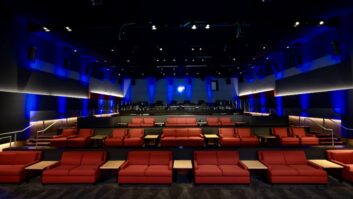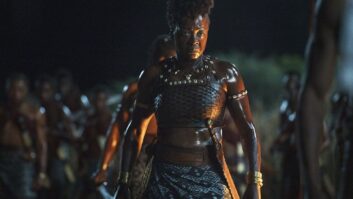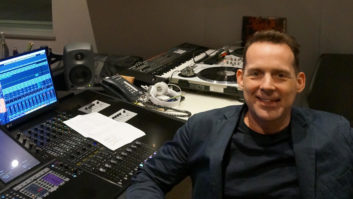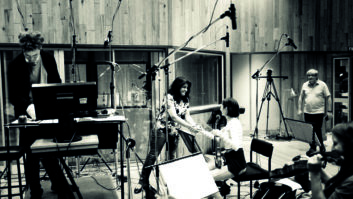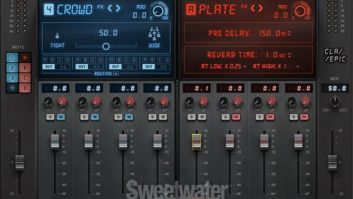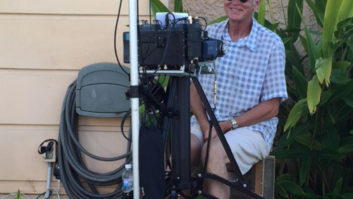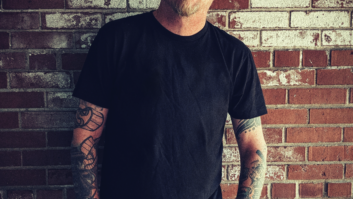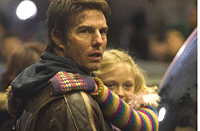
Tom Cruise in War of the Worlds
photo: Frank Connor courtesy Paramount Pictures
You can be forgiven if you don’t know the names Eric Potter and John Fasal. But you’ve undoubtedly heard their work. They are location recording specialists, toiling behind the scenes for days, weeks or months on a film, usually gathering raw material that will become vital elements in a movie’s soundtrack. They’re the guys you’ll find shivering in the snow on a military firing range capturing the sound of an 18th-century cannon; or placing microphones in the attic of an abandoned house and then cutting down a giant tree to fall on the roof; or setting up recording rigs perilously close to rumbling tanks and roaring jets — all in the service of making a great film.
Together, they’ve recorded (or, in their parlance, “shot”) effects for such varied films as Lemony Snicket’s A Series of Unfortunate Events, Master & Commander: The Far Side of the World, Signs, Training Day, Unbreakable, The Jackal, Independence Day and, most recently, Steven Spielberg’s new version of H.G. Wells’ War of the Worlds. (See sidebar.) Individually, Fasal’s long credit list includes Days of Thunder, The Hunt for Red October, Top Gun, The Fugitive, Crimson Tide, The Rock, Con Air, The Fifth Element, The Thin Red Line, Pearl Harbor, all three Matrix films, Men in Black II and Road to Perdition; Potter worked on Speed, Rob Roy, Twister, Solaris, Ronin, Erin Brockovich, The Green Mile, Men in Black, Ocean’s Eleven, The Time Machine, Spider-Man and The Manchurian Candidate, among others.
“They’re absolutely the best at what they do,” comments supervising sound editor Richard King, who has hired the duo to work on numerous films, including War of the Worlds, Lemony Snicket and Master & Commander (which earned King an Oscar). “They’re both really technically savvy and informed and also creative and clever about getting the sounds that are described to them. Both together and independently, they can always figure out how to accomplish it.”
A lot of other sound supervisors evidently agree — Potter and Fasal are not lacking in projects, to say the least. Because of the nature of their job, the duo’s work schedule can be somewhat amorphous, depending on the requirements of a given film. Sometimes, they’re called upon to record just a few select effects that are fairly easy to coordinate; other times, there are unending and time-consuming logistical hurdles to overcome, involving civic or military officials, producers, directors, camera operators — almost anyone can be an impediment (and, conversely, an aide) to their unique needs.
Not surprisingly, both cite the incredible variety of recording situations they face month after month as one of the most satisfying aspects of their work. The sonic universe of Master & Commander couldn’t be more different than War of the Worlds or Lemony Snicket. “Every film has its new challenges and new terminology,” Fasal says. “We learn about jets, tanks, ships, cars…we’ve spent days in shipyards recording sounds and also been on all sorts of firing ranges recording different weapons. You never know what’s going to come up, which is part of what makes it fun.
“And though you think of the job we do as being technical on one level, it’s also very people-intensive, because, often, we are our own front guard in making connections and introducing people to a project and asking for their cooperation. Besides researching what it is they do, you also have to be aware and respectful of their needs. We’re asking for a lot sometimes, and one of the things that Eric and I have in common is we’re people people, so we enjoy learning about these people and involving ourselves momentarily in their lives.”

photo: Frank Masi courtesy Paramount Pictures
Typically, Potter and Fasal are hired by a film’s supervising sound editor, prioritizing their needs based around factors ranging from the film’s shooting schedule — if they are going to capture some sounds on location during filming — to the requirements of various outside parties. Potter notes, “There’s always enough time in our weeks to do the little things, too, because with the big things that require planning and scheduling, you may find you’re on the phone for two days trying to arrange a session with the military or something that requires a lot of coordination and logistical aspects to be worked out. In between phone calls, you can record that alarm clock and the other little things.
“On a picture like War of the Worlds, we’re getting scenes as soon as they’re edited, so we’re starting to see things that need doing,” he continues. “This schedule is so tight and compressed that we get little chunks of picture every couple of days to look at, so we’re seeing a sort of automatic prioritization that way, and then we know there’s some really big stuff coming down the pike that we’ve seen in the script that hasn’t even been shot yet that is going to require a lot of planning. It can take weeks and weeks of calling and planning and auditioning before we can show up and record some of these things.”
So, who are these guys and how did they become location recording’s top dogs?
BACKGROUND IN SOUND
Born in Lancaster, Penn., Eric Potter grew up in Morristown, N.J., and then lived in rustic Western Massachusetts before moving to Boston, where he studied mass communications at Emerson College. As a tyke, he remembers playing with a Sony reel-to-reel tape recorder his father had won at a golf tournament, and later he was impressed by visits to Bell Labs’ museum. “I would get home and take the telephone apart and examine the line and the connectors, then I’d find all these combinations of numbers you could dial to get test tones and tone sweeps from low to high. It was my introduction to electronics diagnostics.”
At Morristown High, Potter worked for the school radio station, WJSV, where “I learned to work with the old Ampex reel-to-reel machines and mixing consoles, getting signals from one place to another and doing live remote broadcasts.” A few years later, at Emerson he got the opportunity one Christmas break to go to Los Angeles to see how films were made. “I asked the person running the Emerson program if there was anything about film sound I could check out,” Potter recalls. “They introduced me to a lot of people and I saw Star Trek IV being mixed; Mark Mangini was supervising sound editor. He was really nice, and it was cool watching him work. That’s when I first realized the sheer magnitude and number of tracks that go into making a film soundtrack. And I remember a real nice vibe on the dub stage, and thinking, ‘I could work with these kinds of people.’”

Supervising sound editor Richard King (L) listens back to tracks recorded by Eric Potter
A semester later, Potter decided to make the move to L.A., where he managed to land a position as a gofer at Weddington Productions, Mangini’s base. “I went over and volunteered and literally swept the parking lot and changed air conditioner filters until some kind of job appeared working in the sound library several months later; then I got hired. That’s where I met Larry Blake and learned all sorts of stuff from him. It was a vital time at Weddington in the mid-’80s — a lot of talented people were passing through there for one film to the next.”
The first sound effect Potter recorded at Weddington was for one of the greatest films ever made — Lawrence of Arabia, or, more precisely, the restored version released in 1989. Weddington partner Richard Anderson called on Potter in a pinch late one night, asking him to quickly come up with some boot stomps for a particular scene. Potter grabbed a Nagra, rushed home to collect his and his roommate’s shoes, then went over to Warner Hollywood and recorded all the stomps he needed in an echo-y hallway. Potter’s real break, though, came when Anderson and co-supervising sound editor David Stone brought him onboard to help create the sounds for Edward Scissorhands‘ steely digits. It was shortly after working on that film that Potter encountered Fasal.
Growing up in the Marin County, Calif., town of Kentfield, Fasal also showed early technical inclinations. He was an inveterate tinkerer, “taking things apart but rarely getting them back together right, at least at first — but I got better at it,” he says with a laugh. He, too, became somewhat interested in recording after his father brought back a Sony 355 from Japan.
However, Fasal’s main interest during — and after — his high school years was music. Beyond playing casuals and solo gigs (guitar), he acted and played in an original musical comedy written by composer/songwriter Brenda Warren. Together, they moved to L.A. hoping to break into show business. They built a demo studio and Fasal got into songwriting. “It was a great time to be here,” he relates. “The punk thing was happening, so there was a lot of energy in the music scene. I was a starving musician, but all our friends were either playing music or acting or doing a showcase for someone. It was a lot of fun.”
To make ends meet, though, Fasal took a job doing transfers at a post-production house called Mag City. “They knew I was a musician and had synthesizers and things, and at one point, they asked me to make some spaceship sounds for something,” he says. “So I got into sound design, usually using Prophets, Oberheims and other gear from my studio. People also started bringing me sounds to process, and the quality of some of them was so bad that I’d record new ones. I worked on a few low-budget films, and at the same time I was still writing and producing songs with Brenda on an 8-track.”

Eric Potter with his highly portable location recording rig
In 1985, through his acquaintance with a sound editor at Mag City named Julia Evershade, Fasal landed a small sound effects job on Motown producer Berry Gordy’s film The Last Dragon. “It had all these karate punches in it,” Fasal recalls, “and they decided they didn’t want to hand-cut every one; they wanted another way to combine them. I had bought an Emulator 2, so they hired me to sample all these Foley hits and library punches and whatever I could get together and make punch combos for all these various hits.” Fasal was installed in a small office in an old building on Hollywood Boulevard, along with Becky Sullivan, a well-known ADR editor and supervisor today. “[The L.A. band] X had a rehearsal room there and sometimes we could hear them playing through the heater ducts. After a while, I more or less segued out of music and into design and recording.”
Fasal credits Evershade with his own ascendancy in the sound business. “She’s a really fantastic editor who kept getting better and better jobs, and she kept recommending me for special sound effects work,” he says. “That’s how I got onto Top Gun [1986], working with Cecelia Hall and George Watters [both supervising sound editors], and another of my favorite early films that I worked on, Ironweed [1987; directed by Hector Babenco]. I shot probably 60 or so ¼-inch rolls of sound effects on Nagra for that. It was all Industrial Age stuff, so I went out to the old Kaiser steel mill out in Fontana that still had that great rumbly sound; it wasn’t modern-sounding at all. I also went to train switching yards and recorded all sorts of impacts and brake screeches, some of which we ended up slowing down so it was almost like a music track. Vicky Sampson was the supervisor on that.”
Fasal and Potter first worked together on Doc Hollywood in 1989. “We met to record a semi truck for Richard King,” Potter remembers. “John had a lot more experience than I did at that point, and one of the first things I noticed about him was that he really seemed to know a lot about microphones.
“In my early years at Weddington, we just had some Schoeps pairs in the closet and those were the SFX mics: CMC 3s and 4s and the MK41 hypercardioid. Occasionally, I’d use the old Radio Shack PZMs for certain situations where there was an interesting flat surface to mount the PZMs on.
“But I remember John had a few different mics with him [on the Doc Hollywood shoot] and he pulled out a Neumann shotgun for the long-in and stops of the tractor-trailer coming from almost a mile away. That’s when I noticed that he was making different choices with different microphones — using Schoeps for some detailed situations and Neumanns for a smooth midrange and lower-mid accents. Later, when we started doing these bigger multitrack situations — like on Independence Day, we sometimes had three or four DAT machines going to record some effects — we got more and more into the idea that you could use different flavors of microphones to capture a single event.”

Fasal recording on ATV, which may be used for any number of sound effects for War of the Worlds
Working on music recordings in conventional studios also expanded their repertoire of microphones. Fasal started using large-diaphragm Audio-Technica 4050s and 4033s in certain applications, and Potter found that “even kick drum mics like [Electro-Voice] RE-20s that can take a big, hot level can be good for recording large tanks and cannons — things that are big and loud and have a deep sound to them.
“I blew up an [AKG] 414 on a gun shoot once,” Fasal adds with a chuckle. “It was one of the dumber things I ever did. I also baked a pair of SM57s that someone suggested I put right under the barrel of a cannon.
“I think of mics like brushes. They’re all good for different things, and certain combinations of mics and recorders are magical, like the Schoeps/Nagra combo. That worked for so many things.”
GOING DIGITAL
The Nagra was still king when Potter and Fasal got their starts, but it wasn’t long before the more portable DAT came into vogue for effects recording. “It was a long transition away from the Nagra,” Potter offers. “Certainly, Edward Scissorhands and various films around that period were mostly done on the Nagra. DAT recorders were available and we were using them in some situations, but we found that we missed the quality of the mic preamps of the Nagra when we recorded to DAT, as well as the tape compression — especially when recording race cars or sports cars, big American V-8 engines, jet aircraft; things with a lot of dynamic range and a lot of punch. Those were still best captured on the Nagra.
“By the early to mid-’90s, though, we started to see the introduction of portable 2-channel mic preamps from guys like Andy Cooper that made interfacing with DAT a lot more palatable,” Potter continues. “That’s when I started being able to make a DAT recording more satisfactorily. At the same time, people on the receiving end, the editors, were much happier to receive things on a DAT than on a quarter-inch reel, what with the program numbers making it easier to find things and the loading easier.
“By 2000, it was a real burden for me to lay a quarter-inch reel on someone, even though it made a superior recording in a lot of ways. The only time I bring out the Nagra these days is for some explosions and gunshots. The strength of the tape compression and the exciting distortion — it’s another flavor that I like.”

John Fasal emerges from a tank during an effects shoot for War of the Worlds
Beginning in 1998, Fasal and Potter added the Zaxcom Deva 4-track digital hard disk recorder to their road kit. “We found them to be very, very reliable, though not optimal,” Potter comments. “I like the way I can reach down and hit that Record button and not have to worry about what’s happening. The foibles of the Deva had to do with us later on exporting the sounds out of the machine and getting them to show up in Pro Tools; it wasn’t really Mac-friendly. But I’ve had that machine in extreme heat and extreme cold, and it’s always performed very well. It had some vibration problems: Riding on an M-1 tank and having it sitting on a chair, it would have a little seizure. [Laughs] Or, one time recording a tilt-a-whirl for [M. Night Shyamalan’s] Unbreakable, John and I had to do a little fancy suspension of the unit to record that. But in general, it’s been a real workhorse.”
Nevertheless, the two have continued to explore other recorders as they come out. On Lemony Snicket’s A Series of Unfortunate Events, they used an 8-channel HHB PortaDrive, and though the higher bit rate capability and additional tracks gave it certain advantages, “I didn’t think it was as well-suited to sound effects recording [as the Deva],” Potter says. “There’s a lot of setup involved and a lot of options that would be good for a production mixer, but are a little too cumbersome for us to use in a down and dirty kind of way. Some of the channels developed residual hard drive noise: The sound of the hard drive spinning would actually leak into the analog electronics somewhere.
“In December [2004],” Potter continues, “I took delivery of a Sound Devices 744T and it’s been a very handy machine. It’s a very small — possibly too small — 4-channel recorder in the same vein as the old Deva II, but spec’d out for us modern Mac users. It’s got a FireWire output for getting the files out. It’s easy: I can hook it up to my Powerbook at the end of the day and pull the sounds off onto the Mac and the sessions will go right into Pro Tools as broadcast .WAV files in Mac format. It’s also a very good-sounding machine. It records all four channels at 192 if you want, and it runs a very long time on a not-so-expensive battery. I have this little Sony camcorder-style battery that I snap into the back of the unit and it’ll go all day long.”
Fasal admits that “I always tend to bring too much equipment [out in the field]. I always have enough inline pads, patch cables or mic stand adapters for everyone, and sometimes I’ll pull out some oddball mics. I can pretty much kluge something together in any situation. I use my [Sound Devices] 442 mixer mostly, but I sometimes bring my Cooper 104 4-channel [mixer]. They have different sounds. I still drag out the DAT machines as a backup to the 744T. Eric and I have used basically everything that you can take out and power with a battery or a car battery, and each one has its strong points.”
Potter and Fasal have an amazingly complementary relationship based on friendship, trust and a mutual love of their work. Of course, not every film has a budget for two location recordists and each continues to work independently. “As the possibilities in film sound have expanded and situations demand a more thorough and spacious sound, it’s become more common for two people to go out,” Potter says. “I’ve gone out with other people, but I’ve found that due to our personalities and our experiences in the field and our working methods, John and I work remarkably well together. We’re able to get a lot of things done in not a lot of time.”
“It’s a great thing,” Fasal says, “because I really trust him in the way he records — if only he’d remember to push Record. [Laughs] Seriously, I know that even if you split us up, with him doing one thing and me another, he’s always going to get great stuff.”
IN THE FIELD FOR WAR OF THE WORLDS
Sound supervisor Richard King describes Speilberg’s War of the Worlds as “an action movie with heart, soul and great special effects.” When King and I spoke in mid-May, the final mix — with the team of Anna Behlmer and Andy Nelson presiding — had just begun, and Potter and Fasal were still delivering new effects to the stage, nine months after their work on the film began.
“We did quite a lot of recording during the production of the film, which is not entirely unusual but not often in this quantity,” Potter says. “For one scene, they took over an entire town in upstate New York to film these scenes of people panicking. At some point, they had up to a thousand extras running through the streets in panic mode, so that’s an example of an opportunity you really can’t re-create in post-production. So we set up our mics and tried to capture as much as we could along with the production [sound]. After a few days of getting that stuff, they were able to cut loose about 300 extras that we took into a quiet neighborhood a few blocks away and had them running around and screaming.”
Both Potter and Fasal ran Devas for those shots: “For some, I would be among the crowd with a boom pole going straight up to get above people’s heads, a general overall stereo shot, and John would often be forward of the crowd or off to the side, getting various medium and medium-long shots.”
Another trip east took the duo to the Red Hook shipyards in Brooklyn to capture sounds and ambiences connected to Tom Cruise’s character in the film. “The shipyard was really a fantastic opportunity because there was quite a bit going on — they were arranging these giant cargo containers and we practically had free run of the place,” Fasal says. “I’m pretty sure we destroyed every OSHA rule that’s ever been written. [Laughs] We were in there booming up within maybe six inches of these containers, and Eric’s directing these trucks that are taking away the containers. We even got to get up on the gantry and crawl out on these catwalks to record various exterior perspectives. The wind was blowing about 30 miles per hour and it was really cold. It was another OSHA nightmare. Once, when the shipyard guy who brought us up there saw that we were happily recording, he said, ‘You guys okay? I’m outta here! It’s too cold,’ so we had another hour of unsupervised recording.”
A while later, Potter and Fasal went on an expedition to record a military convoy down in the Blue Ridge Mountains region of Virginia. “We went up the Maury River to a picturesque rural farm area where military vehicles were staging a convoy to approach the big battle in the film,” Potter recalls. “It was quite an assortment of Humvees, troop carriers and tanks, and they had a minimum of three cameras rolling at all times. These vehicles just kept coming by; it seems like miles and miles of them. I think they actually only had about 20, but they cut them together and it seems like it will never end.
“Due to the many, many takes they shot, we were able to run down or up from where the scene was shooting and capture the vehicles coming by close and medium and long shot. At the end of the day, we figured we’d shot way too much material on this, but now that we’ve seen it cut together, it’s a good thing we did. All those takes could be laid together and they could maintain the continuity of the flow of the convoy without the same sound passing by over and over.”
“And interestingly,” Fasal continues, “even with all the material we shot, we still had to shoot more for some specific moments we didn’t know about until it was cut together.”
According to Fasal, “Almost without fail, the military is very cooperative. When you’re trying to get their cooperation, they need to see a script or at the very least an outline because they want to see how they’re portrayed. And if they like it, they’ll really help you a lot because they see it as a great . Of course, working on a film by Steven Spielberg will open a few doors, too. They were happy to help.”
Do Fasal and Potter always get everything they want from the military? “We’ve gotten pretty good at gauging what you can ask for and how to phrase it in a way that doesn’t make you seem like a jerk,” Potter says. “‘Can you think of some way we could…?’ And we’ve found that if you cue them with headphones it sometimes helps. They hear M-1 tanks firing every day and they hear F-18s flying over all the time and it’s nothing special to them. But you pass them the headphones after getting a few good takes and they’re usually quite amazed, and they often get newly enthusiastic about helping you get more sounds in different ways.”
How often, I wonder, are Potter and Fasal actually in danger? “A lot,” Potter says. “The danger comes from being in unusual or novel situations where you don’t have complete control, so you have to really stay on your toes.” Adds Fasal, “I think the most dangerous ones are when we have to trust someone else’s skills. A lot of times with recording cars, planes, trains — anything that moves fast — you’re trusting that the tires aren’t going to blow and this suspension arm isn’t going to break. We do things with cars at super-high speeds and ridiculous maneuvers — full-on power slides and doughnuts and sessions with cars crashing and sideswiping each other.”
For War of the Worlds, one recording session had the duo in a wrecking yard dropping cars from a forklift to get crashing metal sounds for some of the battle mayhem in the film. And they traveled to the Twentynine Palms marine base in Southern California’s desert to capture the new M1A2 Abrams tanks. Then there was that tough assignment back East getting a bar ambience at a place called the Anchor Tavern: The Irish bartender “made sure our glasses weren’t empty all night,” Fasal says with a chuckle. “There were eight or nine regulars and they had plenty to say and plenty to drink. It took us eight hours — we took the time to meticulously capture this ambience by ingratiating ourselves with the locals, complete with arm wrestling the bartender.”
Just as the final mix on War of the Worlds was starting, Potter spent an afternoon capturing a new engine sound for a Shelby Mustang that appears in the film, and Fasal had a day of recording metal groans and noises in a swimming pool for a scene in which a ferry capsizes, spilling cars and people into the water. Says Fasal, “I had these DPA underwater mics, and also the traditional condom mics, and unfortunately I had a leaker, so I lost a nice AKG Blue Dot mic. We’d used that on Lemony in the condom and it worked real well, but it developed a little tear and then it was snap, crackle and pop. We had two different sound sources: We had speakers actually floating on the surface of the pool on rafts and then we also had an underwater speaker. The problem with recording underwater is getting the low end, so we tried various things, including a subwoofer, which wasn’t effective. But the 15-inch powered monitors worked quite well, and then it became a question of trying different mics and keeping them from getting fried.”
